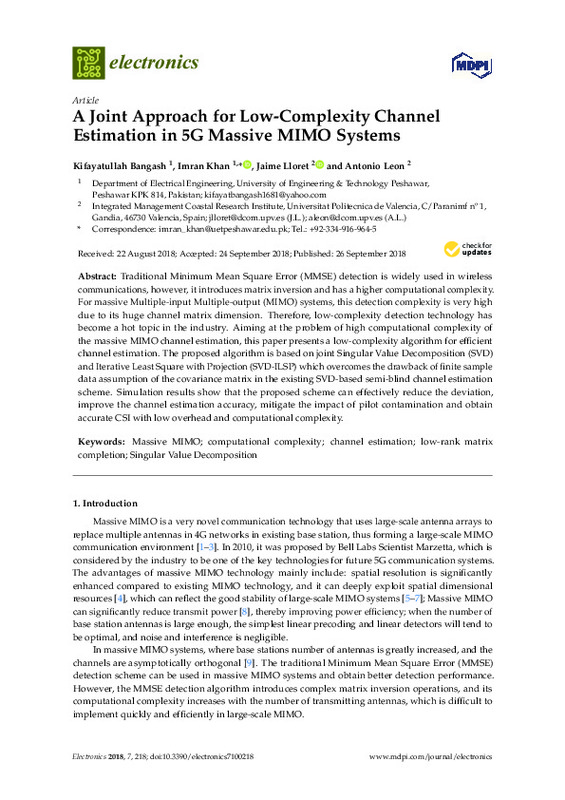Gao, Z., Dai, L., Lu, Z., Yuen, C., & Wang, Z. (2014). Super-Resolution Sparse MIMO-OFDM Channel Estimation Based on Spatial and Temporal Correlations. IEEE Communications Letters, 18(7), 1266-1269. doi:10.1109/lcomm.2014.2325027
Biswas, S., Masouros, C., & Ratnarajah, T. (2016). Performance Analysis of Large Multiuser MIMO Systems With Space-Constrained 2-D Antenna Arrays. IEEE Transactions on Wireless Communications, 15(5), 3492-3505. doi:10.1109/twc.2016.2522419
Khan, I., Zafar, M., Jan, M., Lloret, J., Basheri, M., & Singh, D. (2018). Spectral and Energy Efficient Low-Overhead Uplink and Downlink Channel Estimation for 5G Massive MIMO Systems. Entropy, 20(2), 92. doi:10.3390/e20020092
[+]
Gao, Z., Dai, L., Lu, Z., Yuen, C., & Wang, Z. (2014). Super-Resolution Sparse MIMO-OFDM Channel Estimation Based on Spatial and Temporal Correlations. IEEE Communications Letters, 18(7), 1266-1269. doi:10.1109/lcomm.2014.2325027
Biswas, S., Masouros, C., & Ratnarajah, T. (2016). Performance Analysis of Large Multiuser MIMO Systems With Space-Constrained 2-D Antenna Arrays. IEEE Transactions on Wireless Communications, 15(5), 3492-3505. doi:10.1109/twc.2016.2522419
Khan, I., Zafar, M., Jan, M., Lloret, J., Basheri, M., & Singh, D. (2018). Spectral and Energy Efficient Low-Overhead Uplink and Downlink Channel Estimation for 5G Massive MIMO Systems. Entropy, 20(2), 92. doi:10.3390/e20020092
Khan, I., & Singh, D. (2018). Efficient compressive sensing based sparse channel estimation for 5G massive MIMO systems. AEU - International Journal of Electronics and Communications, 89, 181-190. doi:10.1016/j.aeue.2018.03.038
Khan, I., Singh, M., & Singh, D. (2018). Compressive Sensing-based Sparsity Adaptive Channel Estimation for 5G Massive MIMO Systems. Applied Sciences, 8(5), 754. doi:10.3390/app8050754
Arshad, M., Khan, I., Lloret, J., & Bosch, I. (2018). A Novel Multi-User Codebook Design for 5G in 3D-MIMO Heterogeneous Networks. Electronics, 7(8), 144. doi:10.3390/electronics7080144
Shahjehan, W., Shah, S., Lloret, J., & Bosch, I. (2018). Joint Interference and Phase Alignment among Data Streams in Multicell MIMO Broadcasting. Applied Sciences, 8(8), 1237. doi:10.3390/app8081237
Jose, J., Ashikhmin, A., Marzetta, T. L., & Vishwanath, S. (2011). Pilot Contamination and Precoding in Multi-Cell TDD Systems. IEEE Transactions on Wireless Communications, 10(8), 2640-2651. doi:10.1109/twc.2011.060711.101155
Jose, J., Ashikhmin, A., Marzetta, T. L., & Vishwanath, S. (2009). Pilot contamination problem in multi-cell TDD systems. 2009 IEEE International Symposium on Information Theory. doi:10.1109/isit.2009.5205814
Jose, J., Ashikhmin, A., Whiting, P., & Vishwanath, S. (2011). Channel Estimation and Linear Precoding in Multiuser Multiple-Antenna TDD Systems. IEEE Transactions on Vehicular Technology, 60(5), 2102-2116. doi:10.1109/tvt.2011.2146797
Marzetta, T. L. (2010). Noncooperative Cellular Wireless with Unlimited Numbers of Base Station Antennas. IEEE Transactions on Wireless Communications, 9(11), 3590-3600. doi:10.1109/twc.2010.092810.091092
Rusek, F., Persson, D., Buon Kiong Lau, Larsson, E. G., Marzetta, T. L., & Tufvesson, F. (2013). Scaling Up MIMO: Opportunities and Challenges with Very Large Arrays. IEEE Signal Processing Magazine, 30(1), 40-60. doi:10.1109/msp.2011.2178495
Chang, Z., Wang, Z., Guo, X., Han, Z., & Ristaniemi, T. (2017). Energy-Efficient Resource Allocation for Wireless Powered Massive MIMO System With Imperfect CSI. IEEE Transactions on Green Communications and Networking, 1(2), 121-130. doi:10.1109/tgcn.2017.2696161
Prasad, K. N. R. S. V., Hossain, E., & Bhargava, V. K. (2017). Energy Efficiency in Massive MIMO-Based 5G Networks: Opportunities and Challenges. IEEE Wireless Communications, 24(3), 86-94. doi:10.1109/mwc.2016.1500374wc
Fodor, G., Rajatheva, N., Zirwas, W., Thiele, L., Kurras, M., Guo, K., … De Carvalho, E. (2017). An Overview of Massive MIMO Technology Components in METIS. IEEE Communications Magazine, 55(6), 155-161. doi:10.1109/mcom.2017.1600802
Lu, L., Li, G. Y., Swindlehurst, A. L., Ashikhmin, A., & Zhang, R. (2014). An Overview of Massive MIMO: Benefits and Challenges. IEEE Journal of Selected Topics in Signal Processing, 8(5), 742-758. doi:10.1109/jstsp.2014.2317671
Larsson, E. G., Edfors, O., Tufvesson, F., & Marzetta, T. L. (2014). Massive MIMO for next generation wireless systems. IEEE Communications Magazine, 52(2), 186-195. doi:10.1109/mcom.2014.6736761
Yi Xu, Guosen Yue, & Shiwen Mao. (2014). User Grouping for Massive MIMO in FDD Systems: New Design Methods and Analysis. IEEE Access, 2, 947-959. doi:10.1109/access.2014.2353297
Duly, A. J., Kim, T., Love, D. J., & Krogmeier, J. V. (2014). Closed-Loop Beam Alignment for Massive MIMO Channel Estimation. IEEE Communications Letters, 18(8), 1439-1442. doi:10.1109/lcomm.2014.2316157
Choi, J., Love, D. J., & Bidigare, P. (2014). Downlink Training Techniques for FDD Massive MIMO Systems: Open-Loop and Closed-Loop Training With Memory. IEEE Journal of Selected Topics in Signal Processing, 8(5), 802-814. doi:10.1109/jstsp.2014.2313020
Noh, S., Zoltowski, M. D., & Love, D. J. (2016). Training Sequence Design for Feedback Assisted Hybrid Beamforming in Massive MIMO Systems. IEEE Transactions on Communications, 64(1), 187-200. doi:10.1109/tcomm.2015.2498184
Jiang, Z., Molisch, A. F., Caire, G., & Niu, Z. (2015). Achievable Rates of FDD Massive MIMO Systems With Spatial Channel Correlation. IEEE Transactions on Wireless Communications, 14(5), 2868-2882. doi:10.1109/twc.2015.2396058
Adhikary, A., Junyoung Nam, Jae-Young Ahn, & Caire, G. (2013). Joint Spatial Division and Multiplexing—The Large-Scale Array Regime. IEEE Transactions on Information Theory, 59(10), 6441-6463. doi:10.1109/tit.2013.2269476
Talwar, S., Viberg, M., & Paulraj, A. (1996). Blind separation of synchronous co-channel digital signals using an antenna array. I. Algorithms. IEEE Transactions on Signal Processing, 44(5), 1184-1197. doi:10.1109/78.502331
Comon, P., & Golub, G. H. (1990). Tracking a few extreme singular values and vectors in signal processing. Proceedings of the IEEE, 78(8), 1327-1343. doi:10.1109/5.58320
[-]









